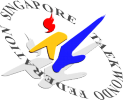The World Taekwondo formed the Para Taekwondo Committee in 2005 to develop and promote taekwondo to athletes of all disabilities. Over many years of development and promotion, the Para Taekwondo Kyorugi and Para Taekwondo Poomsae World Championships are regular features of the global taekwondo calendar nowadays.
In Singapore with the inception of the Singapore Taekwondo Federation (STF) Para Taekwondo Sub-Committee several years ago, the local para taekwondo competition scene has gradually gained visibility post COVID-19 pandemic. In fact, in July 2023, two paraathletes successfully competed in the National Poomsae 2023 Championship.
The STF Para Taekwondo Sub-committee intends to organise a Para Taekwondo Competition in first half of 2024. Para-athletes will be categorised by gender, colour belt and Dan grades. We encourage coaches to share the estimated number of para-athletes indicating the age and impairment to facilitate planning. Please email the information to stkdf@mail.com before Friday, 9 February 2024.
It is our hope to have more para-athletes with different impairment practising taekwondo and competing locally and internationally. To compete, para-athletes must ascertain their impairments are permanent and training cannot improve the conditions. For veracity, a letter from school, medical letter or documents of proof to indicate medical condition are required.
| Sports category | Impairment | Underlying health condition |
|---|---|---|
| P10 – P11/P12 | Visual impairment | • Partial blindness |
| P20 – P21/P22/P23 | Intellectual impairment | • Autism • Down syndrome |
| P30 – P31/P32/P33/ P34/P35 | Neurological impairment | • Hypertonia/Spasticity • Ataxia • Athetosis • Dystonia • Cerebral palsy • Spinal cord injury • Brain injury |
| P40 – P41/P42/P43/ P44/P45 | Physical impairment | • Limb deficiency • Impaired muscle power • Impaired passive range of movement • Leg length difference |
| P50 – P51/52/53 | Usage of assistive technology (wheelchairs, etc.) | • Limb deficiency • Impaired muscle power • Impaired passive range of movement • Neurological conditions |
| P60 – P61 | Hearing impairment | • Deaf • Partially deaf |
| P70 – P72 | Short stature | • Males must be below 145cm • Females must be below 137cm |
| P60 – P61 | Hearing impairment | • Deaf • Partially deaf |
| P70 – P72 | Short stature | • Males must be below 145cm • Females must be below 137cm |
Please email STF if enquiries/clarification regarding the sport category and classification is required. We look forward to more para-athletes practising, participating and competing in the sport of taekwondo and live better through sport.

